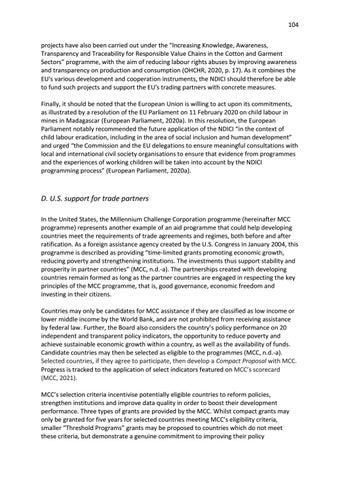104 projects have also been carried out under the “Increasing Knowledge, Awareness, Transparency and Traceability for Responsible Value Chains in the Cotton and Garment Sectors” programme, with the aim of reducing labour rights abuses by improving awareness and transparency on production and consumption (OHCHR, 2020, p. 17). As it combines the EU's various development and cooperation instruments, the NDICI should therefore be able to fund such projects and support the EU's trading partners with concrete measures. Finally, it should be noted that the European Union is willing to act upon its commitments, as illustrated by a resolution of the EU Parliament on 11 February 2020 on child labour in mines in Madagascar (European Parliament, 2020a). In this resolution, the European Parliament notably recommended the future application of the NDICI “in the context of child labour eradication, including in the area of social inclusion and human development” and urged “the Commission and the EU delegations to ensure meaningful consultations with local and international civil society organisations to ensure that evidence from programmes and the experiences of working children will be taken into account by the NDICI programming process” (European Parliament, 2020a).
D. U.S. support for trade partners In the United States, the Millennium Challenge Corporation programme (hereinafter MCC programme) represents another example of an aid programme that could help developing countries meet the requirements of trade agreements and regimes, both before and after ratification. As a foreign assistance agency created by the U.S. Congress in January 2004, this programme is described as providing “time-limited grants promoting economic growth, reducing poverty and strengthening institutions. The investments thus support stability and prosperity in partner countries” (MCC, n.d.-a). The partnerships created with developing countries remain formed as long as the partner countries are engaged in respecting the key principles of the MCC programme, that is, good governance, economic freedom and investing in their citizens. Countries may only be candidates for MCC assistance if they are classified as low income or lower middle income by the World Bank, and are not prohibited from receiving assistance by federal law. Further, the Board also considers the country’s policy performance on 20 independent and transparent policy indicators, the opportunity to reduce poverty and achieve sustainable economic growth within a country, as well as the availability of funds. Candidate countries may then be selected as eligible to the programmes (MCC, n.d.-a). Selected countries, if they agree to participate, then develop a Compact Proposal with MCC. Progress is tracked to the application of select indicators featured on MCC’s scorecard (MCC, 2021). MCC’s selection criteria incentivise potentially eligible countries to reform policies, strengthen institutions and improve data quality in order to boost their development performance. Three types of grants are provided by the MCC. Whilst compact grants may only be granted for five years for selected countries meeting MCC’s eligibility criteria, smaller “Threshold Programs” grants may be proposed to countries which do not meet these criteria, but demonstrate a genuine commitment to improving their policy













